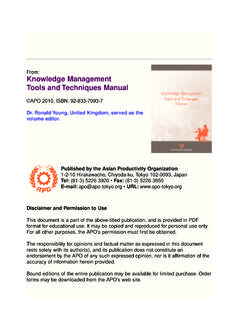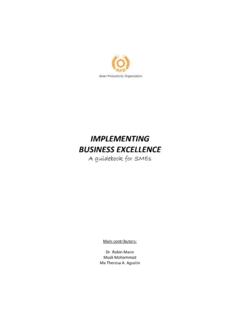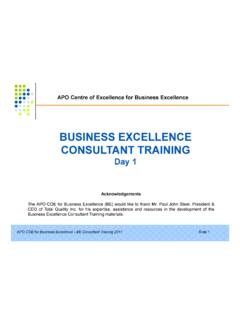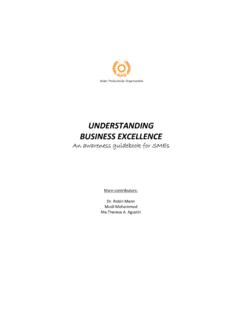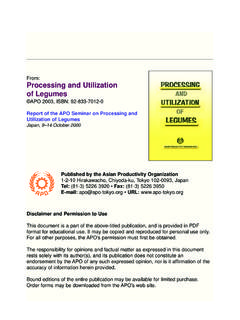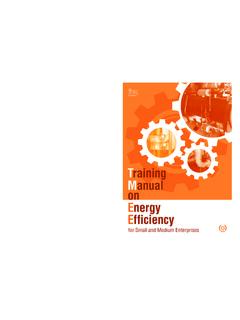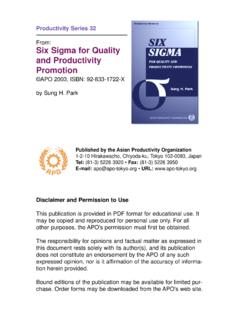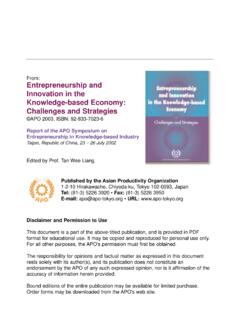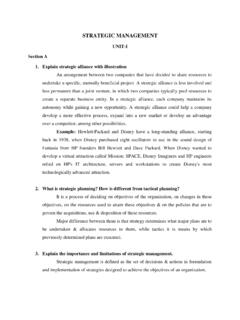Transcription of Strategic Management of Technology and …
1 From: Strategic Management ofTechnology and innovation APO 2007, ISBN: 92-833-7063-5 Report of the APO Top Management Forum onStrategic Management of Technology andInnovationPublished by the Asian Productivity Organization1-2-10 Hirakawacho, Chiyoda-ku, Tokyo 102-0093, JapanTel: (81-3) 5226 3920 Fax: (81-3) 5226 3950E-mail: URL: and Permission to UseThis document is a part of the above-titled publication, and is provided in PDFformat for educational use. It may be copied and reproduced for personal use all other purposes, the APO's permission must first be responsibility for opinions and factual matter as expressed in this documentrests solely with its author(s), and its publication does not constitute anendorsement by the APO of any such expressed opinion, nor is it affirmation of theaccuracy of information herein editions of the entire publication may be available for limited forms may be downloaded from the APO's web of the APO Top Management Forum on Strategic Management of Technology andInnovationThe opinions expressed in this publication do not reflect the official view of the APO.
2 Forreproduction of the contents in part or in full, the APO s prior permission is required. Asian Productivity Organization, 2007 ISBN: of PresentationsCapturing the Value from innovation Introduction to Our Discussionat the Japan Research Center for Technology and innovation Sakakibara3 Original and Without Compare: Zeon Management Strategy toMaximize Corporate Value ..Katsuhiko Nakano6 Importance of Practical MOT Human Resources Developmentand Policy of METI ..Hidehiko Yamachika and Yoshito Goto9 Working for the Benefit of Society Best Matching of Humans & Yamashita11 Effective Collaboration between Major Corporations & Venture Companieson Technology Development for Creating New Businesses ..Noboru Maeda13 Effective Management of Technology Abe16 Denso R&D Kato18 Reforming Japan s innovation System ..Atsushi Sunami20 Panasonic Global R&D Hirayama23II.
3 Additional ContributionThe Importance of the Strategic Management of Technology and Innovationto APO Member Countries in the Current Asian Context and the Sunami29 III. of Participants and Resource ..46 ForewordIn the global economy, companies must enhance their capacity for technologydevelopment and innovation , thereby, enabling the continuous creation of additionalcustomer value. For that reason, many Japanese enterprises have introduced the managementof Technology to utilize the results of advances in Technology in the most productive mannerto offer more competitive products and services. The Management of Technology aims tomaximize the cost-effectiveness of investments in Technology development and ultimatelycontribute to enterprise APO Top Management Forum 2007 was organized in collaboration with the JapanProductivity Center for Socio-Economic Development (JPC-SED) and gathered 35 overseasparticipants from 18 APO member countries, as well as 20 local participants.
4 The forumfocused on the Strategic Management of Technology . A wealth of information on the topicwas offered by the distinguished speakers, and I would like to express my deep gratitude tothem for sharing their knowledge and experience. Thanks to their insightful presentations,the participants had opportunities to examine the Japanese experience and best practices ofthe Management of Technology in enterprises, covering support from the government, creatingleadership and an organizational culture, and human resources development to promotetechnology development and innovation . I hope that the participants will adapt the insightsgained to enhance systems to manage Technology and innovation in their own also would like to express sincere gratitude to the Japanese government for financialsupport and to the JPC-SED for its assistance in organizing the publication contains summaries of the presentations as well as a Strategic paperon the Management of Technology and is intended to help the readers to review the topicscovered in the APO Top Management Forum 2007.
5 I hope that this volume is seen as usefulto those involved in creating new concepts of how businesses can foster innovation to achievesustainable growth in the Asia-Pacific TakenakaSecretary-GeneralTokyoDecember 20073 Capturing the Value from innovation Introduction to OurDiscussion at the Japan Research Center for Technology andInnovation ManagementDr. Kiyonori SakakibaraFaculty of Policy ManagementKeio UniversityNew Technology is a key factor for the success of both companies and nations. Throughactive investment in R&D, Japanese firms have succeeded in generating new , capturing the value from these technologies is also important, and research suggeststhat the relative R&D performance of Japanese manufacturing firms has declined. WhileJapan is very active in R&D investment, capital investment has not followed. In addition,R&D investment has become less has R&D performance worsened in Japan?
6 Some people say that there isoverestimation of technological advantage, less consciousness of technological roadmaps,and continuous and spread investment in the same category of products. The result is thatthe business domain tends to be less focused. Another possible reason is inflexibility in projectmanagement. It is incremental and process-driven rather than target-driven; there is a relianceon continuous teamwork efforts. There is also hesitation in terminating R&D projects, whichincreases challenge of Japan s Technology strategy means that increased networking is nowemphasized. There is currently limited alliance with universities and public research , there is heavy reliance on internal R&D because large Japanese manufacturingcompanies have rich internal R&D resources. Compared to their US and Europeancounterparts, Japanese companies are not very active in initiating international strategictechnology alliances.
7 While Japan s domestic companies are highly R&D-intensive incomparison with other OECD countries, most affiliates of foreign companies in Japan arenot active in R&D in Japan. The implication is that Japan is isolated from the global challenge of Japan s Technology strategy is that it must be more there is no systematic development of a Technology platform as the engine ofgrowth, and there is weak vision and little Strategic focus. The new product developmenttextbook recommends the Stage-Gate system (see Figure 1). This Management techniqueseparates the innovation process into several stages, each stage consisting of a set of prescribedactivities. The entrance to each stage is called a gate. These gates control the process andserve as the go/stop checkpoint. By using the Stage-Gate system we can speed up the productdevelopment process and be more third challenge of Japan s Technology strategy is to capture more value from R& 80% of Japanese patents are never commercialized.
8 The ability to get returns fromtechnological innovations varies between and within industries. I will take the example ofCanon. Its business machines segment is quite profitable, with more than 20% returns onsales. After-sales support and consumable supplies are powerful sources of profit in thisindustry, and therefore the industry itself is profitable. Nonetheless, Canon consistently showshigher profitability than its domestic rivals. The important question is: why?4In 1982, Canon developed the world s first all-in-one toner cartridge for copyingmachines, dramatically reducing the need for nationwide support and maintenance Technology combined not only the consumables but also Canon s proprietarytechnologies, which meant that the company s intellectual property and its profitability wereboth embedded in the cartridge. In 1990, Canon launched a super-compact inkjet printerthat combined the ink tank and the print head in a single disposable unit to make the bodyof the product inexpensive.
9 However, this resulted in high running costs, earning Canonlarge profits from the disposable units. In 1993, Epson launched the MJ-500, which reducedrunning costs by separating the ink tank and print head, in contrast with Canon s response, Canon adopted and patented designs that enabled then to flexibly shift addedvalue between the printer body and the cartridge. The running costs for Canon printerstherefore do not follow a consistent trend over time, bucking the general trend of consistentlyincreasing running conclusion, the case of Canon shows how variation in architecture design candetermine a company s profit profile, so that it is able to meet the competitive conditions inits market while keeping its profitability robust. Implementing innovations is unquestionablyimportant, but simply having strong technologies does not guarantee high and AnswersQuestion: What should be the balance between R&D costs and the profitabilityexpectations for a company?
10 Is there any benchmark for the percentage of company profitswhich should be earmarked as the R&D budget?Dr. Sakakibara: You cannot really be sure what percentage of R&D expenditure isgoing to become profitable. Generally speaking, Japanese companies tend to invest a stablepercentage of total sales as R&D expenditure. Japan s R&D expenditure as a share of totalStage-GateTM: A five-stage, five-gate modelAlong with Discovery and Post-Launch ReviewSource: Robert , Winning at New Products , Third Edition, 2001, 1 The Typical Stage-GateTM Model From Discovery to LaunchIDEA SCREENSECONDGO TOGO TOGO TOSCREENDEVELOPMENTTESTINGLAUNCHSCOPINGB UILD DEVELOPMENTTESTING &LAUNCHBUSINESS CASEVALIDATION STAGE 1 GATE 2 STAGE 2 GATE 3 STAGE 3 GATE 4 STAGE 4 GATE 5 STAGE 5 GATE 1 POST-LAUNCHREVIEW DISCOVERYDRIVING NEW PRODUCTS TO MARKET5sales is high, leading to a huge number of patents being accumulated, but profit from thosetechnological potentials is comparatively low.

